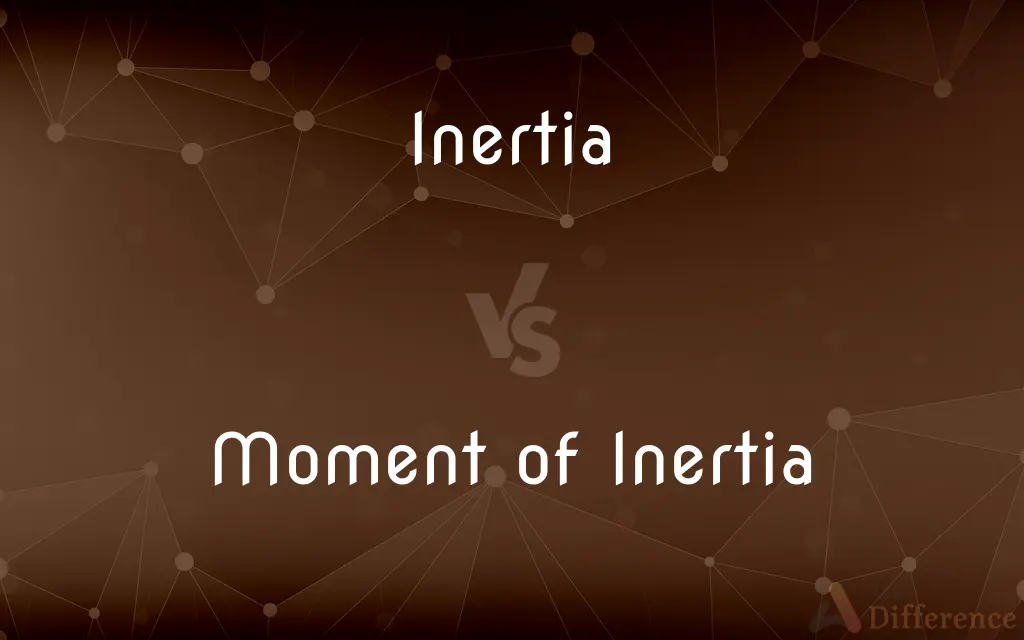Inertia vs. Moment of Inertia — What's the Difference?
By Tayyaba Rehman — Published on October 31, 2023
Inertia refers to an object's resistance to a change in motion. Moment of Inertia, often related to rotation, is a measure of an object's resistance to changes in its rotational motion about an axis.

Difference Between Inertia and Moment of Inertia
Table of Contents
ADVERTISEMENT
Key Differences
Inertia essentially describes an object's inherent tendency to maintain its state of motion, be it at rest or in uniform motion. Inertia is directly proportional to the mass of an object. That is, the heavier an object, the more inertia it has, implying a greater resistance to change in its motion.
Moment of Inertia, on the other hand, is particularly focused on rotational motion. Rather than dealing with straightforward motion or stillness, Moment of Inertia takes into account an object's resistance to changes in its rotating state, factoring in mass and the distance of the mass from the axis of rotation.
Both Inertia and Moment of Inertia play pivotal roles in the principles of motion. Inertia reflects one of Newton's fundamental laws of motion: an object at rest stays at rest, and an object in motion continues in motion unless acted upon by an external force.
Moment of Inertia expands on this principle by applying it to scenarios involving rotation around a particular axis. This concept is critical in studying objects' rotational kinetic energy and evaluating how different shapes and mass distributions affect rotational motion.
In summary, while Inertia and Moment of Inertia fundamentally concern an object's resistance to changes in motion, the key distinction lies in the type of motion being analyzed—linear vs. rotational. They provide insight into understanding and predicting an object's motion based on its physical properties and external influences.
ADVERTISEMENT
Comparison Chart
Type of Motion
Linear
Rotational
Definition
Resistance to change in linear motion.
Resistance to change in rotational motion.
Dependency
Depends on mass only.
Depends on mass and distance of mass from the axis of rotation.
Physical Principle Involved
Newton's First Law
Applies Newton’s first law to rotational motion.
Unit
Kilogram (kg)
Kilogram meter squared (kg m^2)
Compare with Definitions
Inertia
Inertia is an object's intrinsic resistance to any change in its state of motion.
The inertia of the boulder made it difficult to move from its stationary position.
Moment of Inertia
Moment of Inertia incorporates both an object's mass and its mass distribution relative to the rotation axis.
The moment of inertia of a hollow cylinder differs from a solid one of the same mass due to the different mass distribution.
Inertia
Inertia signifies the tendency of a body to maintain its velocity unless acted upon by an external force.
Due to inertia, the rolling ball continued to move until it hit a wall.
Moment of Inertia
Moment of Inertia is critical for determining angular velocities in rotating systems.
Engineers calculate the moment of inertia to determine the power required to accelerate a flywheel.
Inertia
Inertia is the reason objects continue in perpetual linear motion in outer space.
In space, an astronaut’s tool will keep moving due to inertia unless it is acted upon by a force.
Moment of Inertia
Moment of Inertia quantifies an object's resistance to angular acceleration around an axis.
A spinning disk has a definable moment of inertia that describes how it will respond to applied torques.
Inertia
Inertia is a fundamental concept in Newtonian physics.
Newton's cradle visually demonstrates inertia through a series of swinging spheres.
Moment of Inertia
Moment of Inertia plays a role in analyzing objects' rotational kinetic energy.
In physics, calculating the moment of inertia of a gyroscope aids in studying its stabilizing properties.
Inertia
Inertia can be directly proportional to the mass of an object.
A truck, due to its larger mass, has greater inertia than a bicycle.
Moment of Inertia
Moment of Inertia can vary significantly depending on the chosen axis of rotation.
The moment of inertia of a rod rotating about its center is different from that of a rotation about its end.
Inertia
(Physics) The tendency of a body at rest to remain at rest or of a body in straight line motion to stay in motion in a straight line unless acted on by an outside force; the resistance of a body to changes in momentum.
Inertia
Resistance or disinclination to motion, action, or change
An entrenched bureaucracy's inertia.
Inertia
The property of a body that resists any change to its uniform motion; equivalent to its mass.
Inertia
(figuratively) In a person, unwillingness to take action.
Inertia
(medicine) Lack of activity; sluggishness; said especially of the uterus, when, in labour, its contractions have nearly or wholly ceased.
Inertia
That property of matter by which it tends when at rest to remain so, and when in motion to continue in motion, and in the same straight line or direction, unless acted on by some external force; - sometimes called vis inertiæ. The inertia of a body is proportional to its mass.
Inertia
Inertness; indisposition to motion, exertion, or action; lack of energy; sluggishness.
Men . . . have immense irresolution and inertia.
Inertia
Lack of activity; sluggishness; - said especially of the uterus, when, in labor, its contractions have nearly or wholly ceased.
Inertia
A disposition to remain inactive or inert;
He had to overcome his inertia and get back to work
Inertia
(physics) the tendency of a body to maintain is state of rest or uniform motion unless acted upon by an external force
Common Curiosities
What is Moment of Inertia?
Moment of Inertia quantifies an object’s resistance to changes in rotational motion about a particular axis, considering its mass and the distribution of mass.
How do I calculate Moment of Inertia?
Moment of Inertia (I) is calculated by integrating the product of the mass (dm) and square of its perpendicular distance (r) from the axis of rotation: I = ∫r^2 dm.
How is Inertia related to mass?
Inertia is directly proportional to an object’s mass. The greater the mass, the greater the inertia, and vice versa.
How does increasing the mass of an object affect its Inertia?
Increasing the mass of an object will increase its inertia, making it more resistant to changes in its motion.
Can an object have different moments of inertia about different axes?
Yes, the Moment of Inertia varies with the axis of rotation and the distribution of mass relative to that axis.
Can an object have zero Moment of Inertia?
Theoretically, if all of an object's mass is concentrated exactly at the axis of rotation, its moment of inertia would be zero.
Is Moment of Inertia a scalar or a tensor quantity?
Moment of Inertia is a scalar quantity when considering rotation about a single axis, but it's a tensor when considering all possible rotational axes.
How does Moment of Inertia affect the rotational speed of an object?
Greater Moment of Inertia implies more resistance to changes in rotational speed, meaning more torque is required to alter its rotational motion.
What is Inertia?
Inertia is a property of matter that describes an object's resistance to changes in its motion, whether it is at rest or moving linearly.
Why is Inertia considered a scalar quantity?
Inertia is considered a scalar quantity because it only possesses magnitude (mass) and does not have direction.
Is Inertia always conserved?
No, inertia (mass) is not always conserved, especially in processes like nuclear reactions, where mass and energy interchange according to E=mc^2.
What is the physical significance of Moment of Inertia?
Moment of Inertia is significant in predicting how an object will behave in rotational motion, given the mass and its distribution about the axis.
How are Newton's Laws of Motion related to the concepts of Inertia and Moment of Inertia?
Newton’s First Law (Law of Inertia) establishes the concept of inertia in linear motion, while his second law can be applied to rotational motion using the moment of inertia.
What is the principle of conservation of angular momentum in the context of Moment of Inertia?
It states that if no external torque acts on a rotating object, the product of its moment of inertia (I) and angular velocity (ω) is conserved: I1ω1 = I2ω2.
How is linear momentum related to Inertia?
Linear momentum (p) is the product of mass (inertia) and velocity: p = mv.
Share Your Discovery

Previous Comparison
All The Best vs. Best Of Luck
Next Comparison
Bond Dipole vs. Molecular DipoleAuthor Spotlight
Written by
Tayyaba RehmanTayyaba Rehman is a distinguished writer, currently serving as a primary contributor to askdifference.com. As a researcher in semantics and etymology, Tayyaba's passion for the complexity of languages and their distinctions has found a perfect home on the platform. Tayyaba delves into the intricacies of language, distinguishing between commonly confused words and phrases, thereby providing clarity for readers worldwide.














































